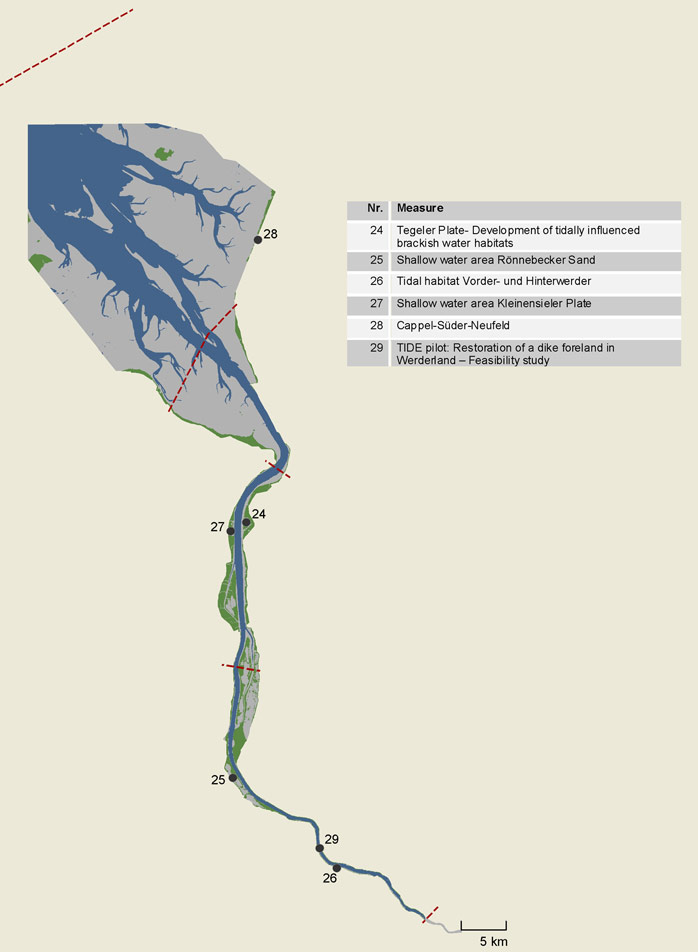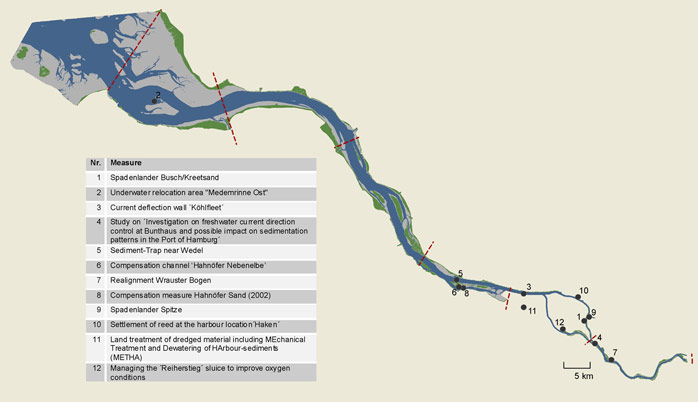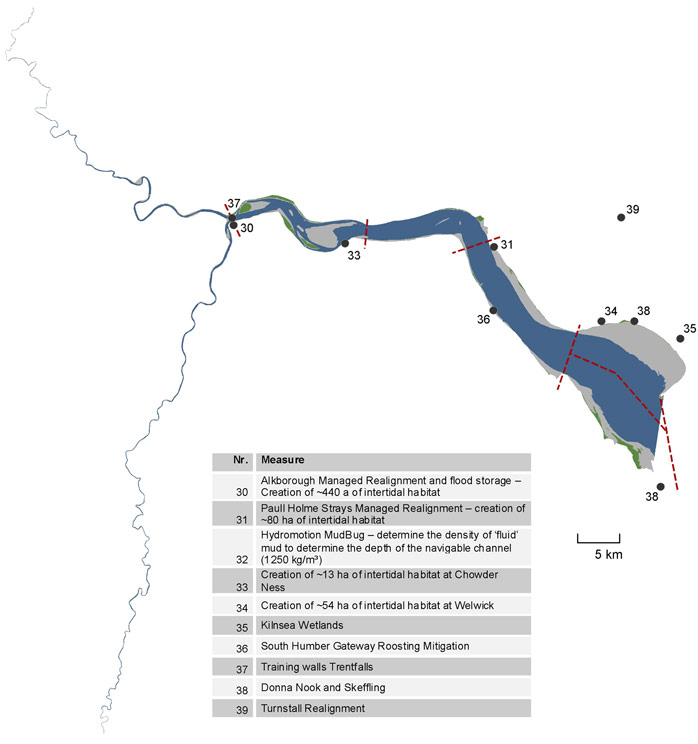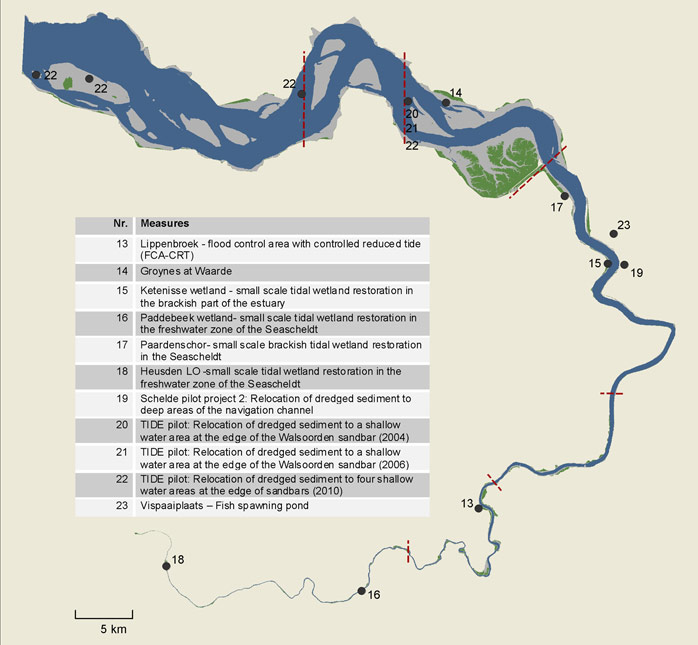

Disclaimer:
The authors are solely responsible for the content of this report. Material included herein does not represent the opinion of the European Community, and the European Community is not responsible for any use that might be made of it.
Back to overview reports
Table 22: Overview on measure examples collected, analysed and compared with indication of short titles and status. The full measure titles can be taken from annex 10.4.
The majority (64%) of measure examples aims at biological and ecological development targets. Approximately one third (29%) was assigned to the measure category ‘Hydrology/Morphology’. Only three measure examples belong to the measure category ‘Physical/Chemical Quality’ (Table 23). A detailed list can be taken from annex 10.5.
Table 23: Number of measure examples collected and assignment to measure category and TIDE estuary
*Measures not assignable to one single measure category are listed multiply. This refers to 3 of 39 measures.
Since the choice of measure examples to be included in the study was left to the members of the TWG measures, the results of the measure collection as compiled in table 22 only show a small part of the totality of measures planned and implemented at the four TIDE estuaries. Additionally, the choice of measures seems to depend on the organisation the respective working group member represents and the connected availability of measure examples: Since the representatives of NLWKN (Weser) and EA (Humber) as organisations in charge of nature conservation and water quality concerns mainly introduced measure examples aiming at biological and ecological development targets, the measure examples introduced by representatives of port authorities (Elbe and Scheldt) belong in almost equal parts to the categories ‘Biology/Ecology’ and ‘Hydrology/Morphology’.
Table 24 shows the measure distribution along the TIDE estuaries according to the estuary zones. Figure 7 shows the location of the measure examples collected in the area of the Elbe estuary. Maps showing the measure locations for all TIDE estuaries can be taken from annex 810.6.
Table 24: Distribution of measure examples collected according to estuary zones
Back to top
How can public acceptance for management actions be increased?
How can the Ecosystem Services Approach be used to support management decisions?
How can we assure accessibility to an inland estuarine port without affecting the habitats and safety against flooding?
How can we prevent excessive degradation or loss of tidal marshes?
How does habitat management affect the supply of ecosystem services?
What are the key areas of conflicts or synergies in TIDE estuaries?
What are the restoration opportunities for side branch systems and river banks (e.g. left side branch Weser)?
What factors determine the distribution of suspended sediments in an estuary?
What measures are successful for the dissipation of tidal energy?
What monitoring is required to support and assess management decisions?
What parameters should be used to define and evaluate measure targets?
What tool is available to help manage multiple users of a resource in an integrated way (i.e. achieving more holistic management)?
Which aspects do I have to take into account in order to make a measure a success?
Which measures are suitable to achieve specific ecological targets?
Which measures are suitable to achieve specific morphological and hydrological targets?
Which measures are suitable to identify, protect or develop valuable submerged habitats e.g. mussel beds and Sabellaria reefs?
Which measures are suitable to improve the physical characteristics and chemical water quality?
Which measures are suitable to provide ecosystem services and benefits?
Which synergistic effects and conflicts can be expected by planning and implementing a certain measure?
“Working with nature”: What are the opportunities for sediment management in estuaries?
Management measures analysis and comparison
Table of content
- 1. Aim of the study
- 2. Work organisation
- 2a. Transnational Working Group Measures (TWG Measures)
- 2b. Regional Working Groups
- 3. Working steps and methods
- 3a. Measure collection and compilation of basic information
- 3b. Analysis approach development
- 3c. Consistency check of analysis results
- 3d. Develop concepts for cross estuary comparison of measures
- 3e. Deduce recommendations for estuary managers
- 4. Pilot projects
- 5. Results of measure collection and analysis
- 5a. Measure collection and basic info compilation
- 5b. Measure analysis
- 6. Specific issues of cross estuary comparison of measures
- 6a. Managed re-alignment measures (APA)
- 6b. Measures influencing sedimentation processes (HPA)
- 7. Summary and conclusions
- 7a. Procedure
- 7b. Results
- 8. Recommendations
- 9. References
- 10. Annex
- 10a. Composition of Regional Working Groups identifying main pressures and resulting deficits for the estuary zone using Environmenta
- 10b. Templates for evaluation of measures in terms of WFD aims: Identification of pressures and explanation of resulting deficits for
- 10c. Templates for evaluation of measures in terms of Natura 2000 aims: Conservation objectives for relevant operational areas based
- 10d. List of collected measure examples from Weser, Elbe, Humber and Scheldt with indication of development targets
- 10e. Assignment of collected measure examples from Weser, Elbe, Humber and Scheldt to measure categories
- 10f. Overview maps on measure titles and locations
- 10g. Assignment of collected measure examples from Weser, Elbe, Humber and Scheldt to measure types
5a. Measure collection and basic info compilation
In total, 39 measures planned or implemented at the four TIDE estuaries were collected (Table 22).Table 22: Overview on measure examples collected, analysed and compared with indication of short titles and status. The full measure titles can be taken from annex 10.4.
| No. | Estuary | Measure example | Status | |
| planned | implemented | |||
| 01 | Elbe | Spadenlander Busch | x | |
| 02 | Elbe | Medemrinne Ost | x | |
| 03 | Elbe | Current deflection wall | x | |
| 04 | Elbe | Bunthaus | x | |
| 05 | Elbe | Sediment trap Wedel | x | |
| 06 | Elbe | Hahnöfer Nebenelbe | x | |
| 07 | Elbe | Wrauster Bogen | x | |
| 08 | Elbe | Hahnöfer Sand | x | |
| 09 | Elbe | Spadenlander Spitze | x | |
| 10 | Elbe | Reed settlement Haken | x | |
| 11 | Elbe | METHA | x | |
| 12 | Elbe | Managing Reiherstieg sluice | x | |
| 13 | Scheldt | Lippenbroek | x | |
| 14 | Scheldt | Groynes Waarde | x | |
| 15 | Scheldt | Ketenisse wetland | x | |
| 16 | Scheldt | Paddebeek wetland | x | |
| 17 | Scheldt | Paardenschoor wetland | x | |
| 18 | Scheldt | Heusden LO wetland | x | |
| 19 | Scheldt | Sediment relocation Ketelplaat | x | |
| 20 | Scheldt | Walsoorden 2004 | x | |
| 21 | Scheldt | Walsoorden 2006 | x | |
| 22 | Scheldt | Sandbars 2010 | x | |
| 23 | Scheldt | Fish pond | x | |
| 24 | Weser | Tegeler Plate | x | |
| 25 | Weser | Rönnebecker Sand | x | |
| 26 | Weser | Vorder- und Hinterwerder | x | |
| 27 | Weser | Kleinensieler Plate | x | |
| 28 | Weser | Cappel-Süder-Neufeld | x | |
| 29 | Weser | Werderland | x | |
| 30 | Humber | Alkborough | x | |
| 31 | Humber | Paull Holme Strays | x | |
| 32 | Humber | MudBug | x | |
| 33 | Humber | Chowder Ness | x | |
| 34 | Humber | Welwick | x | |
| 35 | Humber | Klinsea Wetlands | x | |
| 36 | Humber | South Humber Gateway Roosting | x | |
| 37 | Humber | Trent falls | x | |
| 38 | Humber | Donna Nook and Skeffling | x | |
| 39 | Humber | Turnstall Realignment | x | |
The majority (64%) of measure examples aims at biological and ecological development targets. Approximately one third (29%) was assigned to the measure category ‘Hydrology/Morphology’. Only three measure examples belong to the measure category ‘Physical/Chemical Quality’ (Table 23). A detailed list can be taken from annex 10.5.
Table 23: Number of measure examples collected and assignment to measure category and TIDE estuary
| Measure category | TIDE estuary | Total (%) | |||
| Weser | Elbe | Humber | Scheldt | ||
| Biology/Ecology | 06 | 06 | 08 | 07 | 27 (64) |
| Hydrology/Morphology | - | 05 | 02 | 05 | 12 (29) |
| Physical/Chemical Quality | - | 03 | - | - | 03 (07) |
| Total | 06 | 14 | 10 | 12 | 42* (100) |
*Measures not assignable to one single measure category are listed multiply. This refers to 3 of 39 measures.
Since the choice of measure examples to be included in the study was left to the members of the TWG measures, the results of the measure collection as compiled in table 22 only show a small part of the totality of measures planned and implemented at the four TIDE estuaries. Additionally, the choice of measures seems to depend on the organisation the respective working group member represents and the connected availability of measure examples: Since the representatives of NLWKN (Weser) and EA (Humber) as organisations in charge of nature conservation and water quality concerns mainly introduced measure examples aiming at biological and ecological development targets, the measure examples introduced by representatives of port authorities (Elbe and Scheldt) belong in almost equal parts to the categories ‘Biology/Ecology’ and ‘Hydrology/Morphology’.
Table 24 shows the measure distribution along the TIDE estuaries according to the estuary zones. Figure 7 shows the location of the measure examples collected in the area of the Elbe estuary. Maps showing the measure locations for all TIDE estuaries can be taken from annex 810.6.
Table 24: Distribution of measure examples collected according to estuary zones
| TIDE estuary | Estuary zone | Total | |||
| limnic | oligohaline | mesohaline | polyhaline | ||
| Weser | 3 | 2 | - | 1 | 06 |
| Elbe | 11 | 1 | - | - | 12 |
| Humber | - | 2 | 1 | 7 | 10 |
| Scheldt | 3 | - | 4 | 4 | 11 |
| Total | 17 | 5 | 5 | 12 | 39 |
Important to know
Reports / Measures / Tools
| Report: | Management measures analysis and comparison |
|---|
Management issues
How and by which management measures can tidal amplification be reduced?How can public acceptance for management actions be increased?
How can the Ecosystem Services Approach be used to support management decisions?
How can we assure accessibility to an inland estuarine port without affecting the habitats and safety against flooding?
How can we prevent excessive degradation or loss of tidal marshes?
How does habitat management affect the supply of ecosystem services?
What are the key areas of conflicts or synergies in TIDE estuaries?
What are the restoration opportunities for side branch systems and river banks (e.g. left side branch Weser)?
What factors determine the distribution of suspended sediments in an estuary?
What measures are successful for the dissipation of tidal energy?
What monitoring is required to support and assess management decisions?
What parameters should be used to define and evaluate measure targets?
What tool is available to help manage multiple users of a resource in an integrated way (i.e. achieving more holistic management)?
Which aspects do I have to take into account in order to make a measure a success?
Which measures are suitable to achieve specific ecological targets?
Which measures are suitable to achieve specific morphological and hydrological targets?
Which measures are suitable to identify, protect or develop valuable submerged habitats e.g. mussel beds and Sabellaria reefs?
Which measures are suitable to improve the physical characteristics and chemical water quality?
Which measures are suitable to provide ecosystem services and benefits?
Which synergistic effects and conflicts can be expected by planning and implementing a certain measure?
“Working with nature”: What are the opportunities for sediment management in estuaries?



